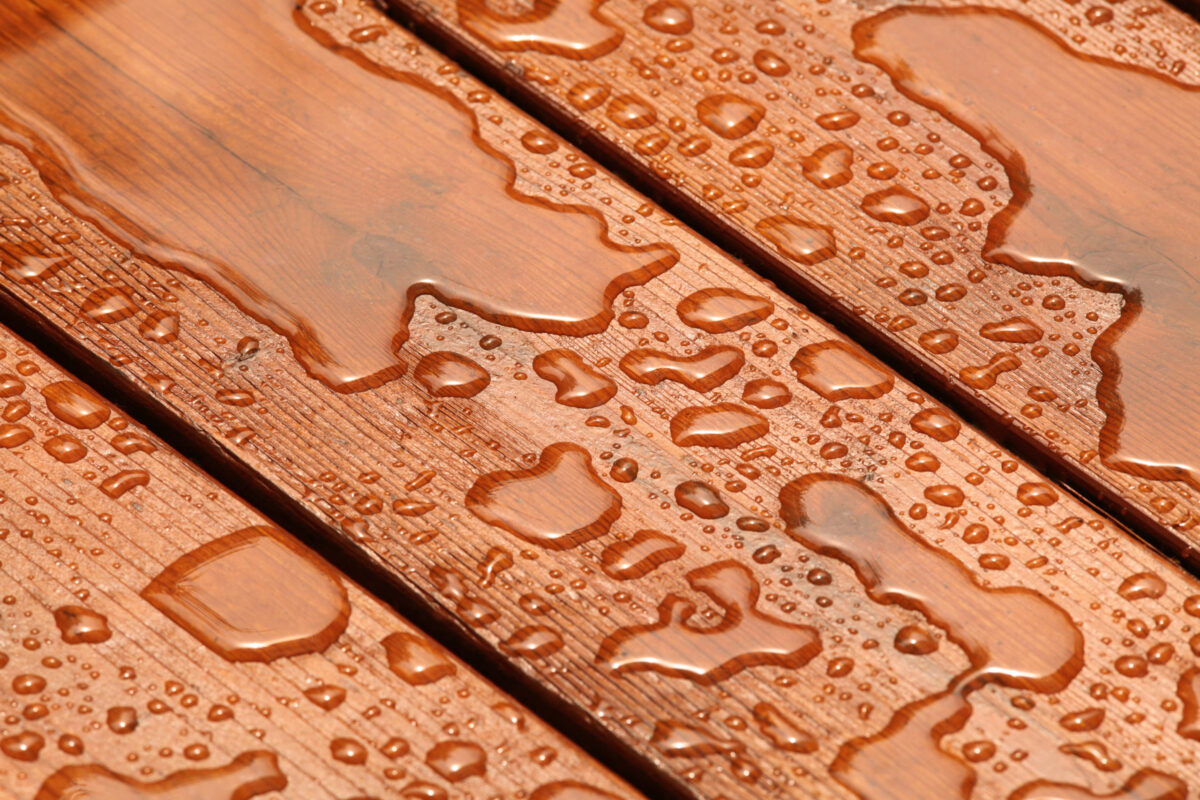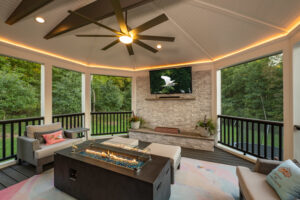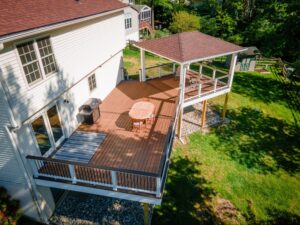A deck is an extension of your living space that is susceptible to the harsh external environment. The scorching heat of the sun, the cold temperature of the winter season, and the humidity can greatly affect the quality of your deck and weaken it over time. That’s where different types of deck stains come in, to preserve your deck’s beauty and lively color and avoid costly repairs.
Staining your deck is extremely important for keeping your deck in great condition. Aside from preserving the aesthetic appeal of your wooden deck, staining also protects it from decay. Moisture can penetrate the materials of your deck more easily if it is not stained; thus, causing premature rotting which brings about a lot of dangers.
When it comes to deck staining, there are three types of deck stains to consider:
- Clear stain
- Semi-transparent stain
- Solid stain
If you are interested in having DeckGuru work on your deck, either fill out a contact form or call us at 571-707-8772.
Clear Deck Stain
If you are looking for a type of deck stain that offers enough protection but leaves the wood looking natural, then a clear stain is a great choice. Clear deck stains and sealers give the needed protection to your wood decking while retaining the natural look of the materials. Apart from that, it can lock the moisture out; thus, increasing the lifespan of your deck. If you live in a moist location or a place that rains constantly, then applying a clear stain on your deck is a good idea.
Unfortunately, clear stains won’t be able to provide protection against the harsh UV rays of the sun; which is another enemy of a deck. When the deck is exposed to too much heat from the sun, it can cause the wood fibers to warp and eventually split, resulting in damage.
Semi-Transparent Deck Stain
Semi-transparent stains are one of the most popular choices by many homeowners when staining their decks. It is water repellent and provides enough protection against the harsh heat of the sun, and at the same time, allows the beauty of the wood to show through. With this, you can be sure that your wood deck is protected against mold and mildew. It doesn’t peel off like what usually happens in paint. Not only that, but semi-transparent deck stains are also easy to apply and reapply.
Semi-transparent stains can be water-based or oil-based. Water-based semi-transparent stains provide longer color retention; thus, letting the natural grain of the deck materials become visible. Oil-based semi-transparent stains, on the other hand, are a bit challenging to apply and would take longer to dry compared to water-based ones. This is because of the modifications in the formula in making oil-based semi-transparent stains in order to meet the VOC standards.
Solid Deck Stain
Solid stains are the type of stains that sit on the wood surfaces only, instead of penetrating the wood materials. The good thing about solid stains is that they give homeowners a wide array of colors to choose from.
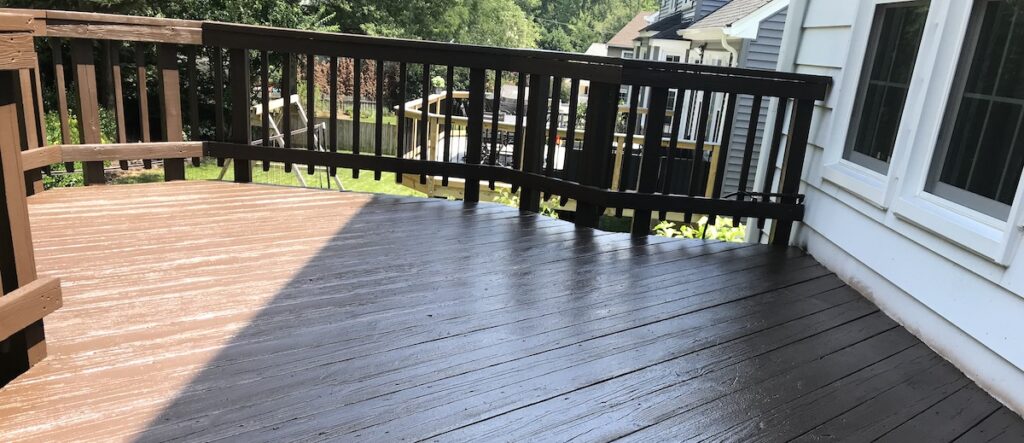
So if you are planning to add color or give a contemporary look on your deck, then solid stain is the best option for you.
Which Type of Deck Stain Should You Choose?
Choosing the right type of deck stain depends on the look you want to achieve, the wood you’re working with, and the level of protection your deck requires. Here’s a breakdown of the three main types of stains to help you decide:
Clear Stains
- Best For: Highlighting the natural beauty of the wood while offering basic moisture protection.
- Appearance: Clear stains allow the grain, texture, and color of the wood to shine through. They provide a natural, untreated look.
- Protection: These stains are good for preventing water damage but lack UV protection. Over time, the wood may gray due to sun exposure.
- When to Choose: Opt for clear stains if your deck is in a shaded area or if you’re willing to regularly maintain the wood to prevent sun damage.
Semi-Transparent Stains
- Best For: Balancing between natural wood appearance and a moderate level of protection.
- Appearance: These stains add a hint of color while allowing the wood grain to be visible, enhancing the wood’s natural texture and beauty.
- Protection: Semi-transparent stains offer UV protection and good resistance to moisture. They last longer than clear stains but still require periodic maintenance.
- When to Choose: Choose semi-transparent stains if you want a natural wood look with added color and moderate protection from the elements. They’re ideal for decks that see some sun but not extreme weather.
Solid Stains
- Best For: Hiding wood imperfections and providing maximum protection in harsh environments.
- Appearance: Solid stains offer the most coverage, hiding the wood grain completely. They come in various colors, giving your deck a more uniform and painted look.
- Protection: These stains provide the most protection against UV rays, moisture, and wear and tear, making them perfect for decks exposed to extreme weather conditions.
- When to Choose: Opt for solid stains if your deck has older wood with imperfections or if you want a bold, modern look. They’re also a good choice for high-traffic areas or decks exposed to direct sunlight.
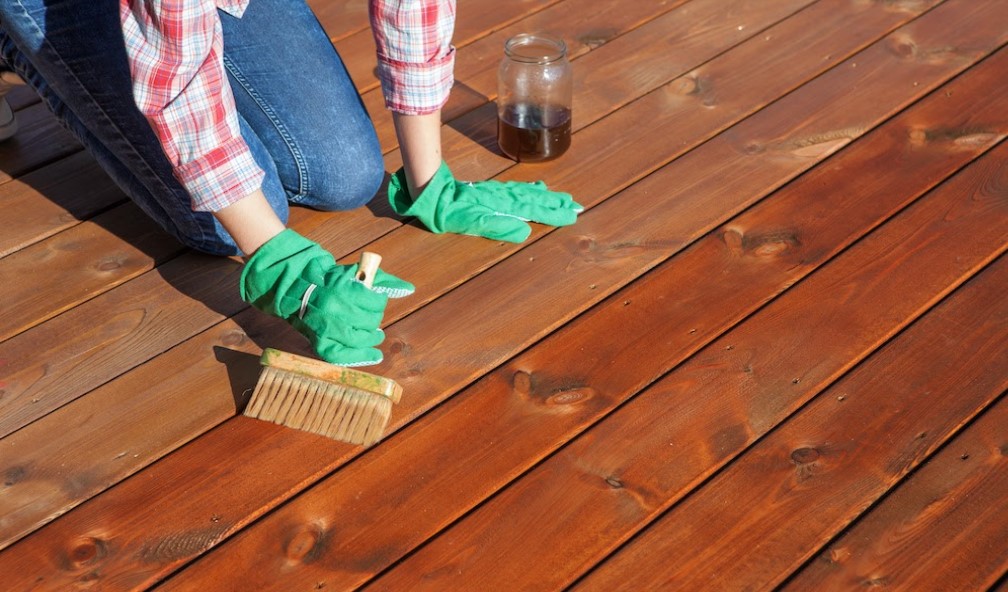
Deck Stains for Different Wood Types
Different wood species react differently to stains, so it’s important to choose a product that complements and protects the type of wood used in your deck. Here’s how to choose the right stain for some of the most common deck woods:
Cedar
- Recommended Stain: Semi-transparent stains are ideal for cedar as they enhance its natural reddish tones while providing UV protection.
- Why: Cedar is naturally resistant to rot and decay, so it doesn’t require heavy coverage. Semi-transparent stains help protect against moisture while highlighting the wood’s natural beauty.
Pressure-Treated Wood
- Recommended Stain: Solid stains work well on pressure-treated wood, especially if it has a greenish tint that you want to mask.
- Why: Pressure-treated wood tends to be more resistant to rot but can have a less attractive appearance. A solid stain helps cover imperfections and provides long-lasting protection from the elements.
Redwood
- Recommended Stain: Clear or semi-transparent stains work best on redwood, allowing the rich, red tones of the wood to shine through.
- Why: Like cedar, redwood is naturally resistant to decay. A light stain can enhance its beauty and provide sufficient protection from moisture and UV rays.
Pine
- Recommended Stain: Semi-transparent or solid stains are both good choices for pine, depending on the look you want.
- Why: Pine is a softer wood that’s prone to wear and tear, so a solid stain can protect it and cover any imperfections. If you want to keep the natural wood look, a semi-transparent stain can add color while offering protection.
Hardwoods (e.g., Ipe, Mahogany)
- Recommended Stain: Use a high-quality clear or semi-transparent stain.
- Why: Hardwoods are extremely dense and durable, so they don’t absorb stain as readily. Clear stains work well if you want to highlight the beautiful grain and natural color, while semi-transparent stains provide some additional protection without obscuring the wood’s natural richness.
Staining Process
Application: Prior to staining, the wood should be sanded smooth and cleared of any dirt or debris. The stain can be applied using a brush, cloth, or sponge. It is recommended to apply the stain in the direction of the wood grain, ensuring even coverage. After application, excess stain should be wiped off with a clean cloth. For a deeper color, multiple coats can be applied, allowing sufficient drying time between each coat.
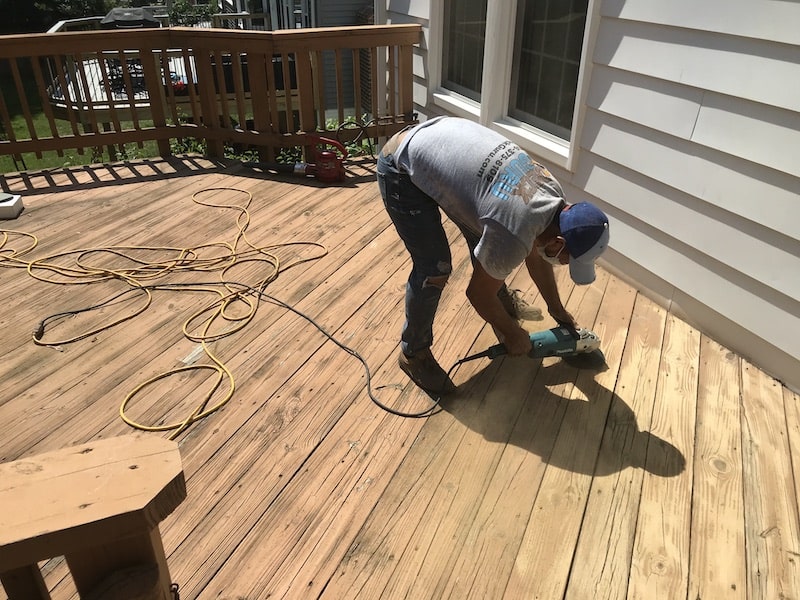
Finish: Once the stain has fully dried, it is essential to protect the wood with a clear protective finish, such as varnish or polyurethane. This will enhance the stain’s longevity, provide added durability, and bring out the shine and luster of the wood.
If you are running into the issue of having to stain your deck every year, you might want to get a Trex Composite Deck. This eco-friendly deck material is great because unlike wood, which fades over time, composite stays vibrant for many years. Wood decks also deteriorate faster than composite, so if your deck is looking a bit unsafe you might want composite for your deck replacement.
If you live in the Northern Virginia area and need help with replacing or repairing a deck, fill out a contact form or call us at 571-707-8772 to get started!

